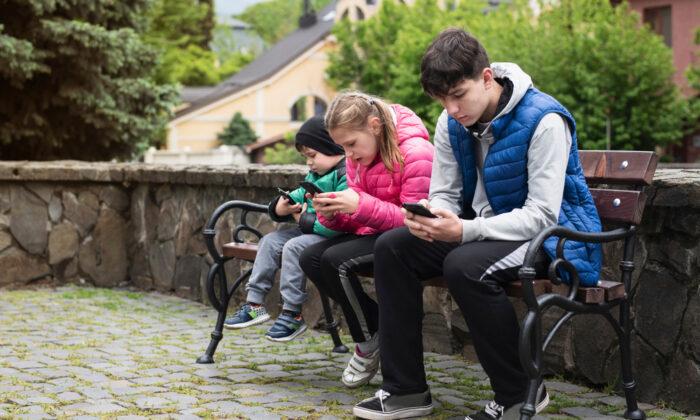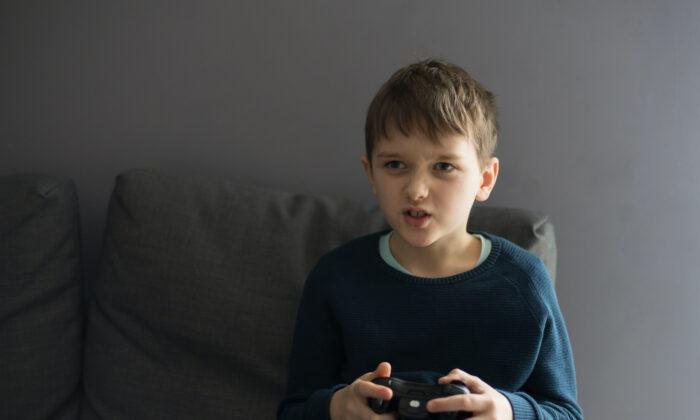I often speak to parent audiences in school settings about screen addiction warning signs and prevention. On the way to the auditorium for a recent parent talk, I found myself wandering through the K-2nd grade hall of a local public school. My youngest of four children is in high school now, so it has been years since I visited an elementary school.
As I walked through the halls, I remembered fondly when my kids were little. Some things were the same: the smell of glue and crayons, and the tiny little backpacks and cubbies. But I began to notice some things were different.
I peeked in a classroom and assumed that I would see those little desks with the chairs attached. But they weren’t there. Instead, the classrooms had strange hammocks and swinging chairs hanging from the ceiling that looked like cocoons. Instead of little chairs at the desks, they had big balls and wobble chairs that I was told were for “active sitting.” My escort, Kathy, the technology teacher, told me that since kids spend so much time indoors on screens, they are entering school lacking the core physical strength to help them actually sit in a chair and learn. Everything in the classroom was designed to accommodate kids with gross and fine motor sensory deficiencies.
She explained these tools are necessary to accomplish the catch-up work needed to build kids’ core strength. There were floor surfers so kids could slide on their bellies across the room, vestibular wedges, a balance disk, and more. “This is the regular classroom. This is standard for our younger students,” the teacher said.
Down the hallway, there were art projects strangely different from those I remembered. Very few were made by hand. Instead, they were photos printed from a digital printer, sloppily cut out, and pasted on poster boards.
“Kid’s do digital art these days, they love the computer,“ she explained. I did get a glimpse of a few hand-drawn pieces outside the door of the first-grade classroom. Kathy said that this teacher doesn’t like to use technology in her classroom. It was refreshing to see something a little more familiar, but the drawings weren’t the trees, families, and flowers one might expect from young children. These drawings were block-like video game characters, computer/tablet screens, and one image with knives, red blood drops, and a disembodied head. I felt like I was in a science fiction movie. Where was the kid art? No houses, no birds or rainbows, and the few families drawn had no detailed faces–remember the wonderful drawing your child brought home on Mother’s Day with the exaggerated eyelashes and big earrings? None of those either.
Their balance is off in more ways than one.
I began to unravel this elementary school mystery when I got home and called Cris Rowan, a pediatric occupational therapist. She explained that the average child spends more time on a screen than asleep. They aren’t getting enough time moving or in free play to build core muscles. They aren’t spending enough time outside in nature—what’s known as a “nature deficit.”“Humans have two sensorimotor systems that are stimulated by movement: the vestibular system located in the brain (often referenced as our “inner ear”) and the proprioceptive system located in our muscles. These two systems integrate with each other and with the visual system to provide core stability, motor coordination, and balance. Children who don’t move enough don’t fully develop these essential sensorimotor systems resulting in poor core stability, coordination, and balance with the consequent need to reach out to use the wall for stability,” she said.
Rowan said nature ignites the imagination in ways a screen never could. Nature stimulates all of our senses—sight, sound, touch, smell, and even taste—in the perfect balance that kids need to develop appropriately. Without exposure to these stimuli, kids become hypersensitive and anxious. I learned that a lack of nature experiences contributes to sensory deficiencies and that physical strength affects brain development. Who knew that holding crayons and learning to read were so dependent on how much time a child spends on the playground? It hit me just how much screen time is robbing our youth of necessary movement and physical exercise. With an increase in sedentary screen time comes attention and learning problems. It made so much sense now.
Kids need to play outside.
My favorite memories of childhood centered around playing outside with my brother. These nature experiences were the building blocks of our personalities and who we became as adults.We learned things outside you could never learn in a classroom. We used our imaginations and innovative skills to build a double-decker tree fort—complete with a trap door—in the avocado tree in our backyard. It was safe enough for us to sleep in. We made mud stew filled with leaves and berries and fought battles with kumquats—the more rotten the better. We became businessmen, selling avocados to the neighbor and investing our earnings in candy from the drug store.
We counted splinters, cuts, and skinned knees as badges of honor. We hung from trees and climbed Mr. Heart’s very tall brick wall daily (it was only five feet tall but seemed like 10 feet tall to us). It came naturally to us to see the backyard as our workplace. We learned to use a hammer, a shovel, and a saw. We rarely complained that we were bored. I have no recollection of our parents being involved in any of our outdoor adventures. We felt independent. We rode our bikes everywhere and our parents didn’t track us.
We worked hard to build our imaginations and strengthen our brains. We learned how to plan, try new ideas, and invent our own fun. We solved problems and invented as we learned how things physically worked. We acted out the Wild Wild West show. I convinced my brother to set up a zip line from the treehouse to the real house. It was a lesson in gravity, speed, and physics.
We dug big holes in the backyard (to make temporary swimming pools), and walked our cute dog, Daisy, twice a day, rain or shine. We got plenty of dirt and vitamin D. Most importantly, we had empty space and ample time to relax and contemplate. We watched 30 minutes of TV a few times a week if it was raining outside.
School was fun.
Recess was our most important period of the day. We got our energy out and then focused on math. Teachers knew that kids who moved a lot learned a lot. We never sat for hours in front of a screen–and neither did any of our peers.We grew physically strong. The whole class participated in fitness programs and we got ribbons for being the fastest runner and doing the most sit-ups and pull-ups. We wanted to win, so we ran a lot at home and at recess to practice. We didn’t need vestibular wedges for our chairs because we swung upside down on the ring swings.
Our emotional health grew alongside our physical strength. We developed confidence and figured out who we were as we became gritty and worked hard. Our identity was based on what our family valued, what we learned, and what we accomplished, not the approval and influence of social media peers or virtual influencers.
We weren’t anxious, we were social. There were no smartphones at lunch and there was plenty of time to build friendships. Our emotional intelligence grew as we spent in-person time with a few close friends at home and a few more at school. Science would eventually explain why quality is better than quantity when it comes to building friendships.
We were practicing our executive function skills as we worked through awkward conversations with peers without being able to text mom for help or sympathy. We learned to compromise and cooperate and communicate. And the mean girls only got to be mean till three o’clock, then everyone went home for a break and a good night’s sleep.
Kids are lost in a virtual bubble.
Now imagine growing up in today’s world without learning how to climb trees, build forts, and balance your favorite book, bubblegum, and baby dolls as climb up to the treehouse. Imagine never feeling the soft but sometimes itchy grass on your bare feet, and the feeling of that same grass when it gets wet and slippery as you run through the sprinklers. The sun, the mud, the made-up games in the backyard—the average child is missing out on all of that today. They are living in a physically sterile and emotionally toxic virtual bubble instead.How to fill the void?
Today’s kids are starving, empty, and missing out. The only way to fix the problem is to replace the volume of hours spent on screens with the rich benefits of nature, in-person relationships, and purposeful downtime. Remove the toxic screens from our kids’ lives, and replace them with time spent in nature.The best antidote for screen overuse is to go play outside.
This fix is easier than you might think. For younger kids, only a few weeks of a new low-screen time routine will reset their brains. For older teens, with brains that have already been shaped by the screen culture, it will be harder. But it is possible. I’ve seen it happen many times.
It’s hard for kids to be in nature and not move. Outdoor time helps children expend energy and calm down. If their energy isn’t expended, it turns into stress. To put it in adult terms, proper exercise doesn’t exhaust you, it keeps you healthy and relaxed. And if you’re wondering why kids can’t use screen-based games to relax, it’s because screen-based activities aren’t relaxing. Ask any adult who tries to use Facebook as a relaxation technique: It overstimulates the brain and only increases stress and anxiety.
7 Warning Signs Your Child has a Screen Dependency
- Screen activities are the only thing that puts child in a good mood
- Unhappy when forced to unplug
- Screen use is increasing over time
- Only thing that motivates child
- Sneaks around to use screens and lies about use
- Increase in anxiety and stress
- Screen use interferes with family activities, friendships, or school






